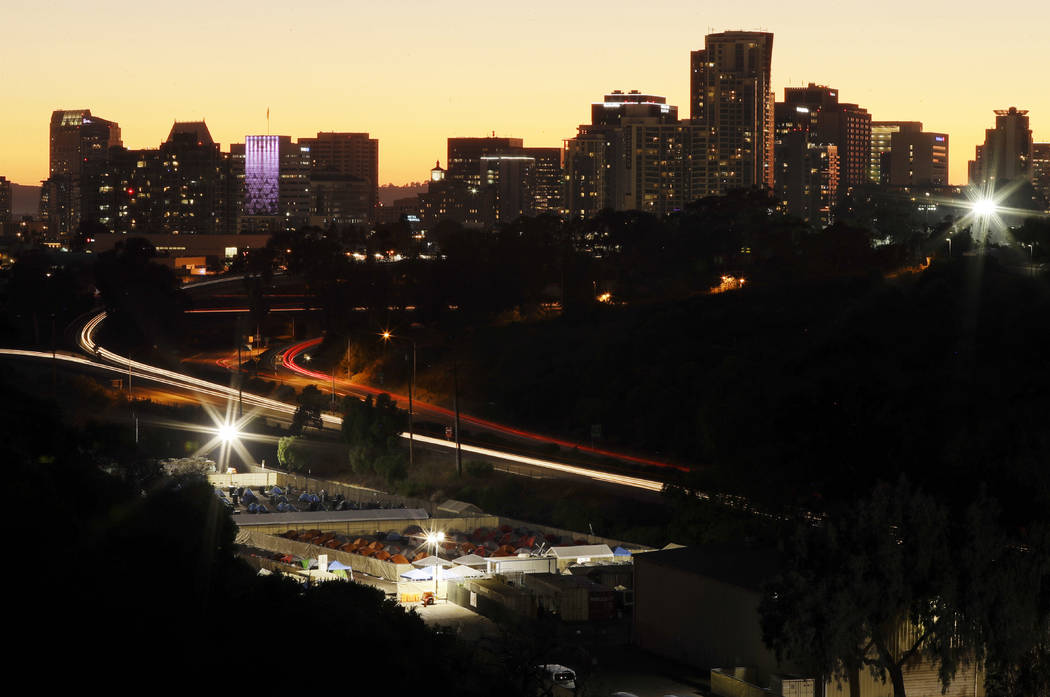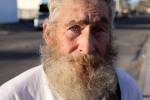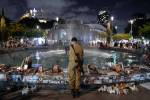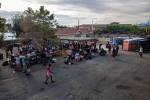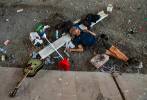Rising homeless population in San Diego flocks to tents
SAN DIEGO — For Christine Wade, the tent she shared with six children, pitched in an asphalt parking lot, was far better than their previous home — a shelter where rats ate through the family’s bags of clothes.
“It’s peaceful here,” Wade, 31 and eight months pregnant, said in an October interview at the campground.
A tent, of course, is not a home. But for these San Diegans, it is a blessing.
Like other major cities all along the West Coast, San Diego is struggling with a homeless crisis. In a place that bills itself as “America’s Finest City,” spiraling real estate values have contributed to spiraling homelessness, leaving more than 3,200 people living on the streets or in their cars.
Most alarmingly, the deplorable sanitary conditions help spread a liver-damaging virus that lives in feces, contributing to the deadliest U.S. hepatitis A epidemic in 20 years.
“Some of the most vulnerable are dying in the streets in one of the most desirable and livable regions in America,” a San Diego County grand jury wrote in its report in June — reiterating recommendations it gave the city over the past decade to address homelessness.
San Diego has struggled to do that. Two years ago, Mayor Kevin Faulconer closed a downtown tent shelter that operated for 29 years during winter months. He promised a “game changer” — a new, permanent facility with services to funnel people to housing.
But it wasn’t enough.
The result? Legions of Californians without shelter. A spreading contagion. And an extraordinary challenge to the city’s sunny identity that threatens its key tourism industry.
For now, San Diego again is turning to tents. The campground where the Wades lived served 200 residents but was only temporary; this month, officials are opening three industrial-sized tents that will house a total of 700 people.
There are plans afoot to build housing. But to deal with the immediate emergency, the city had to take $6.5 million that had been budgeted for permanent homes to operate the giant tents.
‘We don’t have enough housing’
“The people of San Diego need to decide what they want the city to look like,” said Gordon Walker, the head of San Diego Regional Task Force on the Homeless. “San Francisco has essentially given up its streets to the homeless. It could go either way here. The real issue is we don’t have enough housing.”
Last year, the number of people living outdoors in San Diego jumped 18 percent over the previous year, according to an annual count taken in January. More than 400 makeshift shelters covered downtown sidewalks alongside new apartment high-rises.
In October, Faulconer teamed with the homeless services provider, Alpha Project, to open the Balboa Park campground where the Wades found shelter. The city installed public washing stations, opened 24-hour restrooms and scrubbed streets with a bleach solution.
Police also cited people. Within weeks, the nearly 400 tents and tarps downtown disappeared.
Meanwhile, the number of encampments along the banks of the San Diego River doubled.
The San Diego River Park Foundation — whose mission is to preserve the river that feeds into the Pacific — spent $115,000 removing 250,000 pounds of trash left by the homeless camps this year.
Director Rob Hutsel said potential donors ask him when he talks about plans for a 52-mile-long river park and trail system: “What about the homeless? Don’t build a park. It’ll just bring in more.”
“There shouldn’t be any thought about building a park,” he said. “That’s so unfortunate.”
The mayor has earmarked more than $80 million to reduce homelessness over the next three years.
“Ultimately the goal is to put everyone in a home who wants to be,” Faulconer said.
But units need to be built, and the temporary solution is expensive. At a cost of $1,700 per person per month, $6.5 million will cover seven months, but the tents may need to remain open for up to two years, according to the San Diego Housing Commission’s head, Rick Gentry.
Meanwhile, San Diego County has spent $4 million to contain the hepatitis outbreak that has killed 20 people and sickened more than 560 in the past year.
Residents face hardships
At Perkins Elementary School, the student body is more than a quarter homeless, up from 4 percent three years ago.
Shawnni Wade was a straight-A student as a third grader. But when her family’s troubles escalated, she left the school; now, she’s returned as a seventh grader.
“It’s weird to be back,” said the girl with bright green eyes and a sly smile.
But then, little about this 12-year-old girl’s life has been normal.
Christine Wade blames her ex-husband’s drug addiction. After they divorced, he let Wade care for his two daughters. She rented a kitchenette. But then she lost her job, and Wade discovered she was pregnant.
She could find space only in the rat-infested shelter, where the family lived before landing in the campground.
Then, a few weeks ago, Wade was hospitalized with an infection. She could not return to the campground, so the family moved into yet another shelter.
A caseworker is now helping her find a home. She hopes to have one before next month, when she expects to give birth to a son.
Homelessness in Las Vegas
'Campus' for homeless in Las Vegas on track to open in March
More Las Vegas homeless living without shelter, census shows
Churches, agencies feed homeless in downtown Las Vegas
Homeless population in Southern Nevada increases






